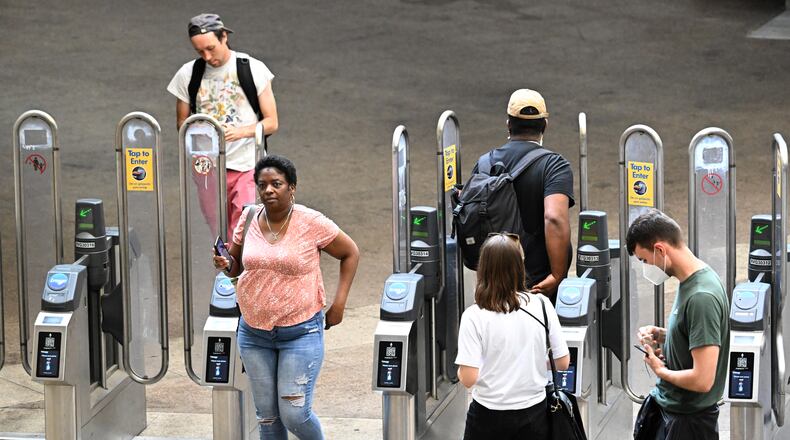For the next two months, MARTA is setting out to answer whether the agency could make it free to ride a train or bus in the city of Atlanta.
The study comes at the request of the Atlanta City Council, which passed an ordinance in early June asking MARTA to look into whether it would be feasible to implement fare-free transit within the Atlanta city limits.
The agency is expected to report back on its findings in early October.
Proponents of free fares say it could increase ridership and alleviate costs for families — and the study could be the first step toward making it a reality.
“It seemed to be a sensible time to revisit, how do we make MARTA more accessible to people? How do we encourage more people to ride? How do you get more people out of cars as it affects our environment?” Councilman Michael Julian Bond said.
Credit: Jason Getz / Jason.Getz@ajc.com
Credit: Jason Getz / Jason.Getz@ajc.com
The study will only focus on the impact of fare-free MARTA within Atlanta city limits, but Bond hopes neighboring cities and counties that have MARTA service could eventually contribute to an expanded fare-free program.
The idea has the backing of Atlanta Mayor Andre Dickens, who said when he was running for mayor last year that he wanted to see MARTA become free by 2030.
“I love it,” Dickens said recently when asked about the study. “I’m all here for it, and I’m grateful that my council colleagues are pushing that, and I look forward to the day that we get there.”
Still, the idea could face a number of hurdles, primarily surrounding how MARTA or the city would make up for a millions in lost fare revenue. And it remains to be seen whether it would have the political buy-in from MARTA’s board or other officials. MARTA leaders have traditionally said their most common feedback from riders surrounds the frequency and reach of bus and train service, not the cost.
Colleen Kiernan, MARTA’s senior director of government and community affairs, estimated the agency could lose around $60 million in fare revenue if rides were free.
Credit: JOHN SPINK / AJC
Credit: JOHN SPINK / AJC
That’s less than a quarter of its nearly $560 million operations budget, but it’s still a sizeable amount of cash that the city, MARTA or another source would have to make up if fares were eliminated.
“It’s substantial,” Bond acknowledged, adding that “it’s not what they’re wholly dependent on.”
The study is expected to shed some light on the financial question. The council’s ordinance specifically asks MARTA to research:
- The cost of providing fare-free transit in the city
- The funding streams available to the city and MARTA
- A timeline for implementation
- A cost analysis of other cities in the United States that offer fare-free transit
- Partnerships that the city can establish to bolster the effort
Other cities around the country have implemented fare-free transit programs in recent years, including an initiative in Boston that made three bus lines in lower-income communities of color free to ride. That followed a pilot program on one bus line that showed promising results, according to the city of Boston: Ridership on the free bus line surged to 92% of pre-pandemic levels.
“I have spoken with so many families who have said it’s been life-changing to not have to worry about how to cobble together enough change in your pocket for that day to get to class, and to know that this is a service that is truly available to everyone,” Boston Mayor Michelle Wu told The Guardian last month.
In Pittsburgh, the city offers a “fare-free zone” running between six light rail stations in the city’s core. And Baltimore has a privately funded initiative that offers free rides on four bus routes throughout the city.
MARTA itself has some recent experience with offering free trips.
When the pandemic first hit, the agency waived bus fares, asking passengers to board from the back door to reduce contact with drivers. While it didn’t reach pre-COVID levels, bus ridership increased throughout that period, and sharply decreased when the fares were reinstated, MARTA data shows.
MARTA also has a reduced fare program for people over 65 and those with disabilities.
Joseph Hacker, a public management and policy professor at Georgia State University, said supporters of fare-free MARTA will need to nail down their goal — whether that’s increasing ridership or promoting equity — to successfully implement the program.
And without upgrades in services or other initiatives accompanying the policy change, Hacker said, ridership may not drastically increase. (MARTA is in the process of redesigning its bus network, and is seeking public input on whether to offer more frequent bus service on fewer routes.)
“You’re sort of putting a fresh coat of paint on something,” Hacker said. “It’s splashy and it’s a step in the right direction perhaps, but it really needs it be packaged with other things.”
In a column for The Atlanta Journal-Constitution last year, MARTA’s former CEO, the late Jeffrey Parker, provided a glimpse into how the agency has traditionally thought about the idea of fare-free service.
“What I hear is our customers wish our service went more places more often, not that it costs too much to ride,” Parker wrote. “Addressing those needs of our customers will do far more to advance equity in the region than providing free fare on the system that exists today.”
About the Author
The Latest
Featured




